Last updated: March 8, 2025
Article
Coming Full Circle: How Parks Are Using Conventional Tools in New Ways to Restore Imperiled Forests
Depriving western old-growth forests of fire brought them to the brink. Now the fire they need also threatens them. To fix this, parks are returning to mechanical forestry methods.
By Jennifer Gibson, Leonel Arguello, Anthony Caprio, Garrett Dickman, Eamon Engber, Eric Knapp, and Jason Teraoka
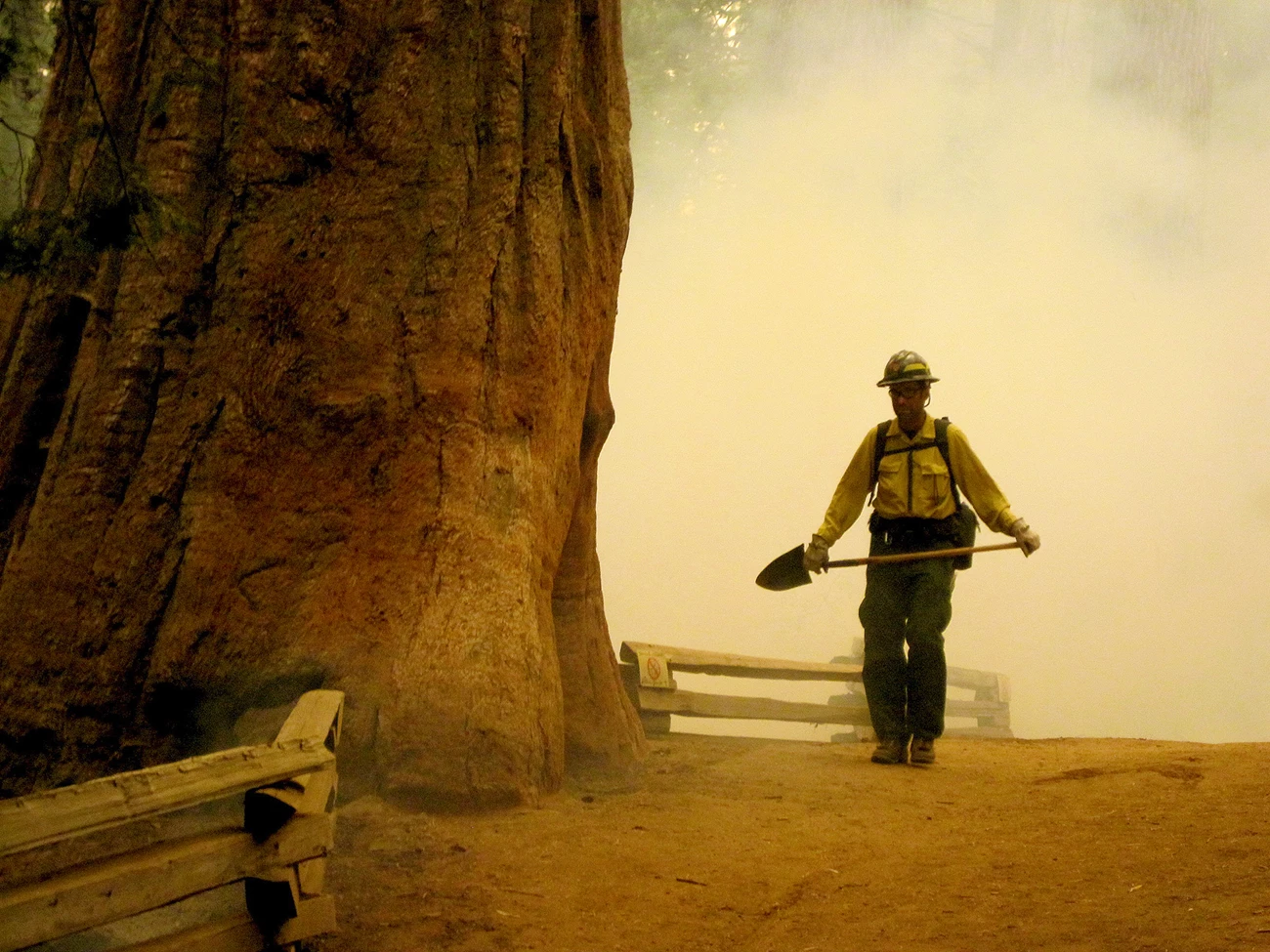
Image credit: NPS / G. Dickman
The contrast was stark. Some of Whiskeytown National Recreation Area’s forests buzzed with a diversity of sounds. Others seemed dark, dense, and eerily silent.
In one area, it was as if you walked into a closet and shut the door—no sounds of lizards sprinting in the leaves, no bees buzzing, no birds calling. Something didn’t seem right. The forest hadn’t always been that way. It used to be a sunny, open oak woodland with scattered ponderosa pine and other conifers. This site had transitioned to a dense, dark Douglas fir-dominant forest in a very short time. Now it wasn’t just dark but dangerous to itself and others. The densely packed, struggling trees and abundant dead wood were the fuels for a devastating fire waiting to happen. Prescribed fire was no longer an option. Our only solution was to return to conventional forestry techniques, using mechanized equipment like feller bunchers, skidders, and grapplers. The associated ground disturbance was an inevitable impact to save the plant community.
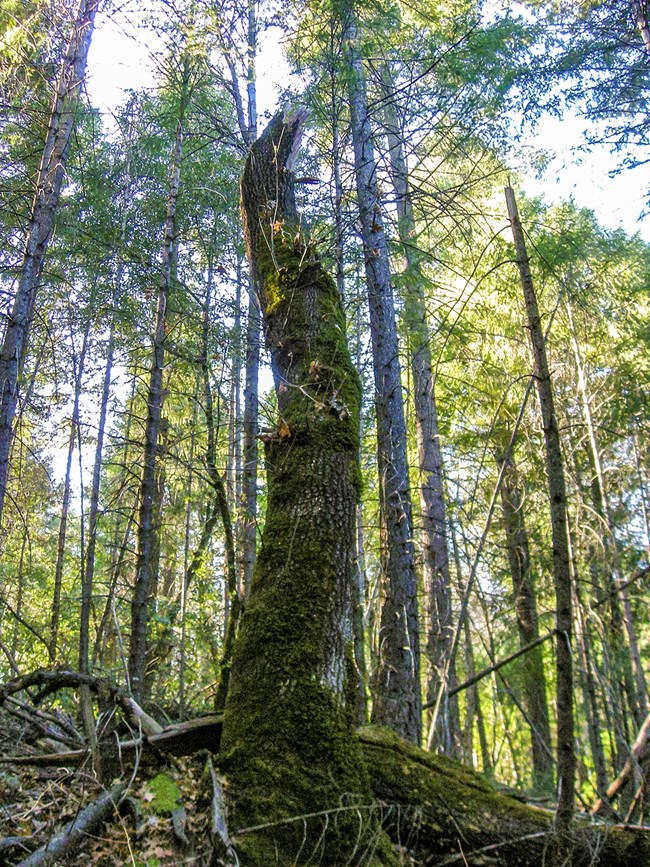
Image credit: NPS / Jennifer Gibson
Clues to an Ominous Change
In my former role as an ecologist at Whiskeytown, I (Gibson) hosted fire ecology and forestry classes to help piece together the historic conditions of the park’s lower- and middle-elevation plant communities. The challenge was figuring out what had happened. By analyzing tree size and age, as well as looking at the spacing of live trees and stumps, the students concluded that these specific areas were selectively logged in the 1950s and 1960s. The largest and most valuable conifers had been harvested, leaving behind other species like oaks and young or imperfect conifers. The ponderosa pines and big black oaks we saw had been there since pre-European settlement.
In the absence of cultural burning, fire frequency declined. Settlers also began actively suppressing fires as early as the 1880s.
Before the logging, as recently as one hundred years ago, the oak and pine woodlands were most likely maintained by the local Wintu Tribe. The Wintu was one of several Native American Tribes that lived in the Klamath Mountains. The Tribes used fire for such things as improving hunting conditions and promoting growth of certain plants for food and cordage materials like shoes, clothes, and fishing line.
Black oak acorns were a valued food source for Native American Tribes. They often targeted black oak stands for frequent, low-intensity burning to facilitate acorn production. This active burning augmented lightning ignitions, which were also common. Frequent fire created gaps in the canopy and produced a rich seed bed. Sunlight reached the forest floor, resulting in diverse understory plants and allowing tree seeds to germinate.
By the mid-1800s, European-American settlers began to homestead in the area around what is now Whiskeytown Lake. Colonization of the Whiskeytown area by the settlers led to a devastating decline of the Wintu. The new arrivals harvested lumber to build homesteads and mining infrastructure, and they grazed their sheep in the once sunny and grassy woodlands. In the absence of cultural burning, fire frequency declined. Settlers also began actively suppressing fires as early as the 1880s. It is this lack of fire disturbance that resulted in the shift from a ponderosa pine and black oak woodland to a forest dominated by Douglas fir.
In some areas, the students and I found evidence of competition-induced stress and mortality, with a lot of dead, woody material on the forest floor. We also noticed that the black oaks did not have spreading limbs, which they normally would have if conditions had been open and sunny. Instead, they dropped their limbs over time. Tree canopies became just a scraggly branch or two chasing the little remaining light from above. Later, I began to see the same pattern across the park’s middle elevations—dead or dying oaks embedded in a Douglas fir forest. The once diverse and critically important pine-oak plant community that supported so much wildlife was fading away on our watch.
From Observations to Action
Our observations on Whiskeytown’s college fire ecology field trips prompted us to collaborate with the University of Montana’s Department of Forest Management. We worked with the university to collect data and develop prescriptions for restoring the park’s mixed conifer and black oak woodlands. Our objectives were to accelerate the development of old-growth characteristics, reduce the risk of crown fires (those that spread from treetop to treetop), improve the health of overstory trees, and make future prescribed fire operations easier.
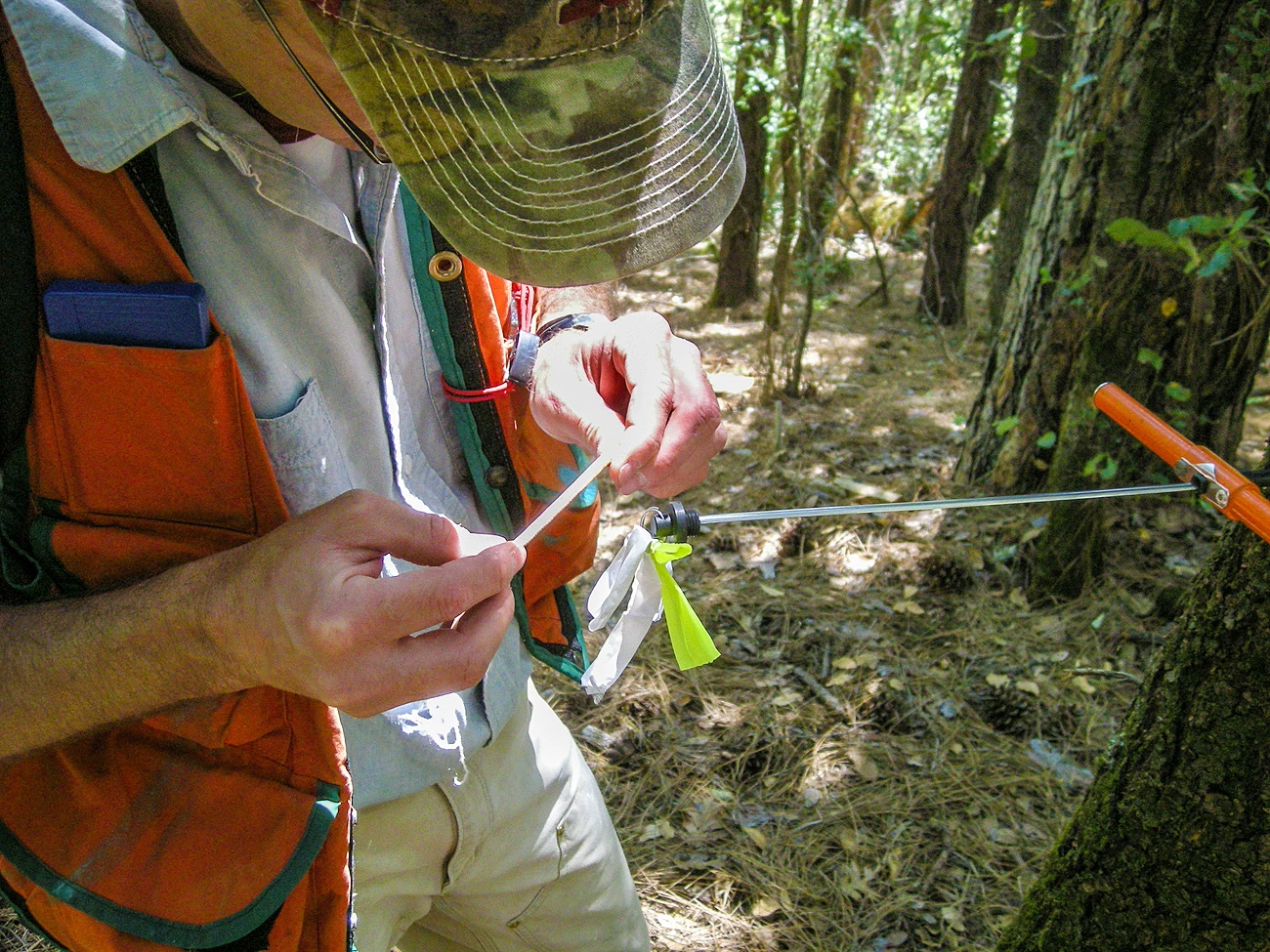
Image credit: NPS / Jennifer Gibson
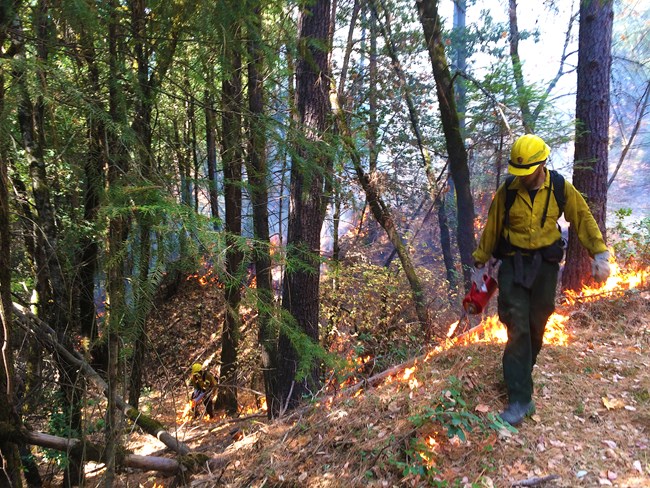
Image credit: NPS / Jennifer Gibson
The park carried out its first forest and oak woodland restoration project in Whiskeytown’s Brandy Creek watershed in 2010. This was a pilot project that used heavy equipment to mechanically thin 12 acres through a partnership with the local resource conservation district. A much larger 75-acre project in the Boulder Creek drainage followed, made possible by a 2014 General Services Administration timber sale, where the proceeds from removing the encroaching conifers paid for the oak woodland restoration. The park installed long-term monitoring plots prior to the treatments to measure the success of these efforts. The park applied prescribed fire to the original 12-acre project area in 2017.
Our Whiskeytown restoration work was tested in 2018 by the Carr Fire, which burned 97 percent of the park.
Our Whiskeytown restoration work was tested in 2018 by the Carr Fire, which burned 97 percent of the park, much of it severely. Unpublished results show that in mixed conifer and oak woodland, fewer trees died, and fire damage was less severe in areas treated with mechanical thinning and prescribed fire. Fuel treatments around park headquarters as well as the Oak Bottom Fire Station also allowed crews to successfully defend those areas during a period of extreme fire behavior. The sections that were thinned then burned by prescription up to five years prior to the wildfire suffered the least damage.
Coauthor Eamon Engber was the fire ecologist and lead resource advisor for the National Park Service at Whiskeytown during the Carr Fire. "We observed spot fires...that went out naturally due to discontinuities in surface fuels resulting from the recent prescribed fire treatment," Engber said, adding that in one thinned-out unit, "crown fire transitioned to surface fire when it hit the treatment area, [but] the heat pulse and intensity still resulted in high levels of crown scorch and subsequent tree mortality."
Engber thought this might have been averted if there was a "larger buffer around the residual trees" and the area had been "broadcast burned following thinning operations to further reduce surface fuels." On the western boundary of the park, Engber said fire crews were able to "tactically utilize" previously treated areas on ridge tops and the park boundary for locating fire lines and gaining access to fight the fire.
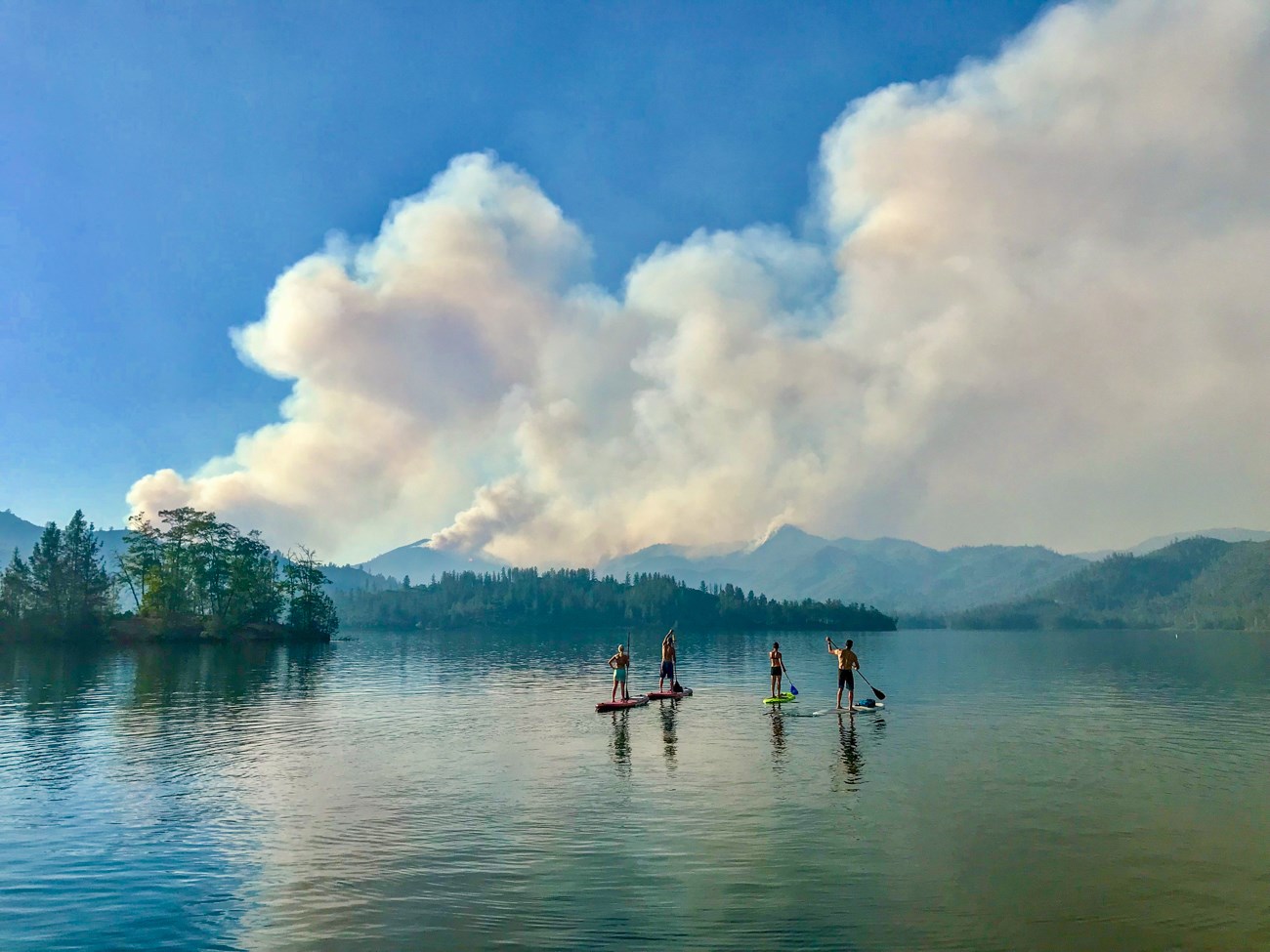
Image credit: NPS / Matt Switzer
A Repeating Pattern
The pattern of old-growth forest and woodland being replaced by encroaching shade-tolerant species is present throughout the West. Historically, lightning-caused fires and regular burning by Indigenous communities created and supported meadows and oak woodlands, and reduced stand density in forests. This fostered large, often widely spaced conifers that were more resilient to severe fires, disease, and drought. But fire suppression, timber extraction, and other land use practices in the western United States have significantly altered old-growth, fire-dependent forests since the 1900s.
Since at least 1968, scientists have recognized that suppressing fires—stopping them once they started—has adverse long-term consequences. In the absence of fire, these forests become unnaturally dense. Coauthor Eric Knapp is a research ecologist with the U.S. Department of Agriculture, Forest Service. “By reconstructing what old-growth forests used to look like,” said Knapp, “we know that many areas of the Sierra Nevada have two to five times more trees than just 110 years ago.” This excess density has made them vulnerable to wildfires, drought, and insect attacks. Such forest conditions also favor shade-loving tree species that, in the absence of fire, can outcompete the sun-loving species they once co-existed with.
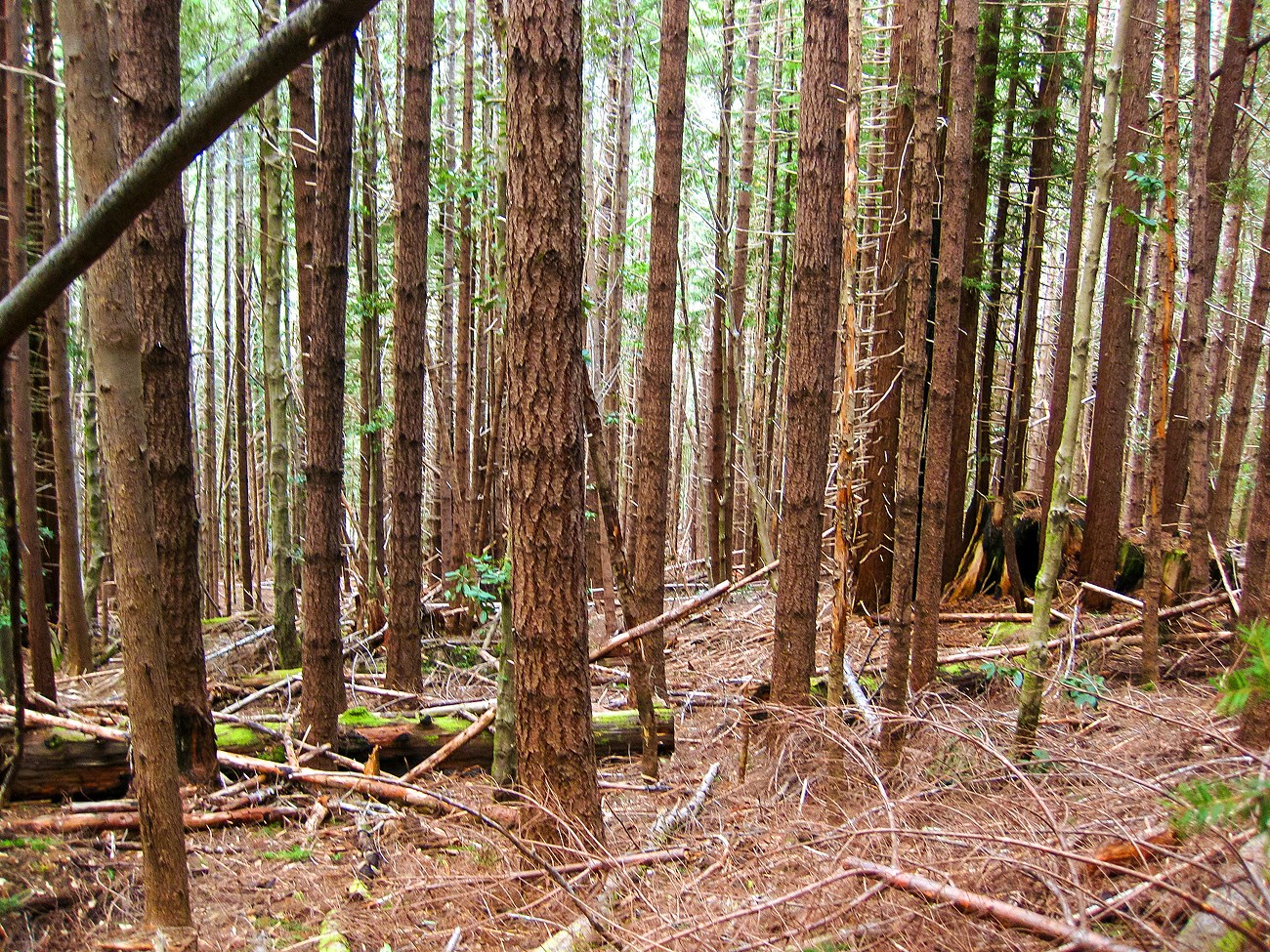
Image credit: NPS / Jason Teraoka
The surplus trees compete for water, which decreases soil and downstream water availability. In turn, this decreases the extent of meadows and wetlands that support perennial waterways and many different animals and plants. The increased number of trees also causes fallen leaves and branches to build up. This creates huge loads of fuel—dead branches, trees, and leaves—on the forest floor, standing against the trees, and up in the canopy, a “perfect storm” of fire-prone conditions.
But Douglas fir and other shade-tolerant forests aren’t inherently bad; the issue is the loss of an entire plant community or habitat, like oak woodlands. Oak woodlands are critical ecosystems with cultural, ecological, and esthetic importance to parks and visitors. They provide food and cover for a wide range of wildlife and harbor diverse assemblages of native bird and plant species. For example, oak woodlands contain important denning sites for the at-risk Pacific fisher. They also supply important ecosystem services like air purification, water conservation, and soil retention. Oak woodlands still retain great cultural and spiritual significance for Native Americans, who have used them for shelter and subsistence activities, like acorn gathering and hunting, for thousands of years.
When Removing Trees Brings New Life
Prescribed fire has long been a tool for land managers to use to reduce fuels and mimic the effects of natural fires. This is effective when fire-sensitive encroaching trees, like white fir, incense cedar, and Douglas fir, are seedlings or saplings. But as the encroaching species increase in size, they become more resistant to the low intensity of typical prescribed fires. Only under the hottest burn prescriptions could prescribed fire kill the larger-diameter trees that have encroached over the last 70–100 years. Unfortunately, such intense fire can also kill older legacy trees that are already stressed and weakened. “It may sound counterintuitive,” said Knapp, “but we’ve removed fire from the system for so long, that it’s now much more challenging to get back to a desirable density and structure by just reintroducing fire.”

Image credits: NPS / Jason Teraoka
As shown by our pilot study, in these situations, mechanical thinning can mimic some effects of prescribed fire. This is increasingly supported by science, which has demonstrated that thinning can reduce air quality impacts, increase water yield, reduce tree stress, and improve tree health. The goals of these thinning treatments are to retain and recruit old-growth and large, vigorous, mature trees and allow the subsequent use of low-intensity prescribed fire to maintain the stand in perpetuity.
Restoring Old-Growth Redwoods
When gold was discovered in 1849, thousands of European-American immigrants went to Northern California. Back then, there were about two million acres of old-growth redwoods in the area. Commercial logging followed as people depended on lumber for shelter, and rot-resistant redwood became a prized commodity. By the 1960s, industrial logging had removed almost all the original redwoods. By then it was a common practice to plant faster growing Douglas fir where redwoods had been removed in order to meet timber industry production demands.
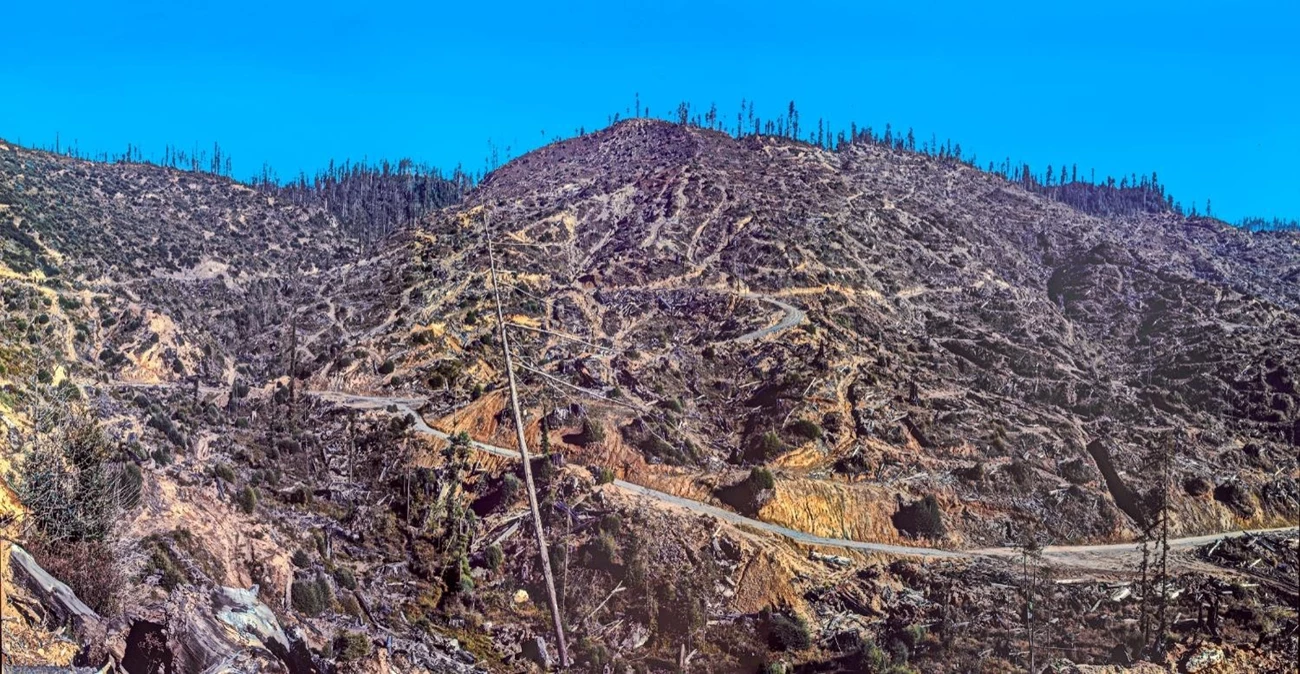
Image courtesy of David van de Mark
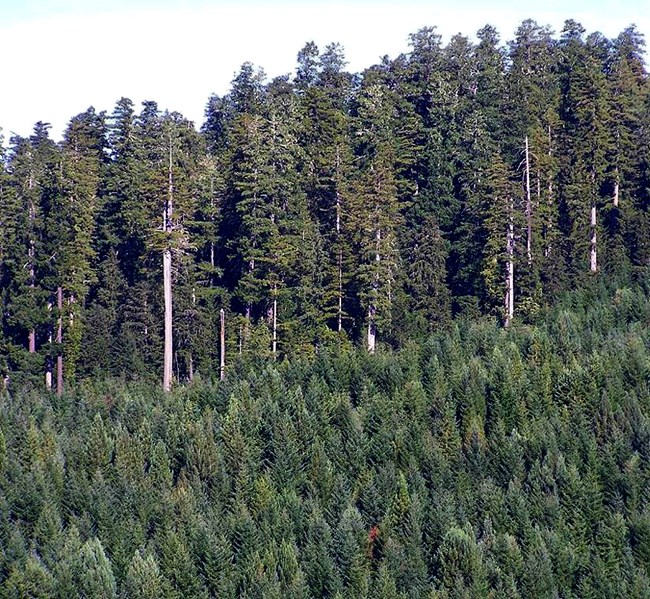
Image courtesy of California State Parks
There are currently 80,000 acres of second- to third growth-redwood stands and 40,000 acres of old-growth forest in Redwood National and State Parks. The differences in height and forest structures between the old-growth and adjacent younger, second-growth forests create edge effects. These can alter environmental and biological conditions hundreds of feet into the old-growth forest. Edge effects reduce available old-growth habitat for certain species, decreasing the effective size of the old-growth stands.
Land managers routinely aerially seeded or planted conifer species other than redwood into clear cuts, including exotic tree species.
Many of these young stands have too many even-aged trees and too uniform a stand structure—a result of industrial forest practices. Land managers routinely aerially seeded or planted conifer species other than redwood into clear cuts, including exotic tree species. These conditions created intense competition for light and nutrients and resulted in very tall trees with poor crown development and little understory vegetation or young trees.
To put young, second-growth forests on a trajectory towards old-growth structure and function, Redwood National and State Parks began testing mechanical thinning of young forests as early as 1978. Success from those earlier trials prompted the park to continue testing thinning until 2009, when the park completed its first programmatic plan to thin 1,700 acres of second-growth forest in the South Fork and Lost Man Creek watersheds. This led directly to the Redwoods Rising partnership and restoration work now underway across 43,000 acres of second-growth forest in the parks.
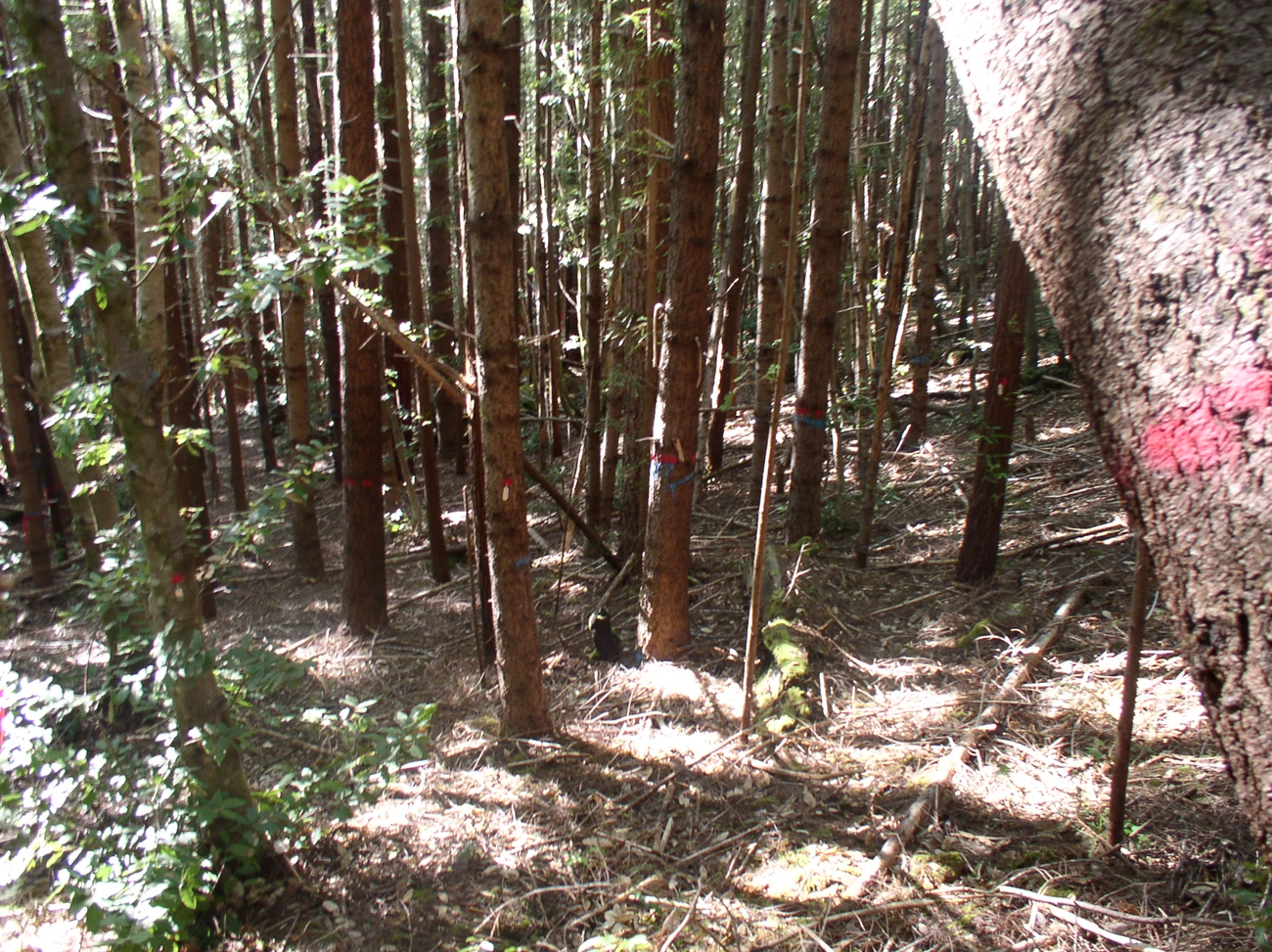
Left image
Decades ago, forest managers commonly planted Douglas fir after clearcutting redwood forests. The California coast's climate and soils enabled the firs to grow rapidly into dense thickets. This is one monitoring plot before restoration thinning.
Credit: NPS / Jason Teraoka
Right image
The same plot five years after thinning. There's now a diverse understory of shrubs and herbaceous plants. Drag the slider to the right or left to see the difference.
Credit: NPS / Jason Teraoka
These large-scale treatments are designed in the short term to shift species composition favorably, improve understory development and habitat availability for plants and wildlife, improve stand growth and vigor, and increase biodiversity. Additional benefits include moderating undesirable edge effects on existing old-growth redwood forests, improving carbon sequestration as trees begin to grow faster, and increasing fire resilience as younger trees grow thicker bark and canopy heights increase.
Saving the Sequoia Groves
Fire exclusion in giant sequoia groves began in the 1860s when land use changed because of Euro-American settlement. Park managers actively suppressed fires after the 1890 creation of Sequoia and General Grant (later to become Kings Canyon) National Parks. This was the longest fire-free interval in the Sierra Nevada’s sequoia groves for the last several thousand years or more. Park managers didn’t know it, but these practices were weakening the groves and making them susceptible to stand-replacing fires that kill large adult trees.
In the 1960s, scientists began to understand the importance of fire in the Sierra Nevada landscape, particularly for giant sequoias: giant sequoia ecosystems aren’t just adapted to periodic fire; they depend on it.
Fire suppression caused burnable material to accumulate. When trees and shrubs become more densely packed and logs, sticks, and fallen leaves or needles build up on the ground, fires are more likely to be severe. In contrast, when fire burns more often, it thins out younger trees and reduces fuel. In the 1960s, scientists began to understand the importance of fire in the Sierra Nevada landscape, particularly for giant sequoias: giant sequoia ecosystems aren’t just adapted to periodic fire; they depend on it.
Tree-ring studies examined the scars left by past fires in Giant Forest and Atwell Groves in Sequoia and Mariposa Grove in Yosemite National Park. They showed that fire in sequoia groves occurred every five to 25 years, mostly burning in the forest understory. Sequoias live thousands of years, and the population was stable or increasing up through the 1800s. But in the 1900s, many giant sequoia trees failed to reproduce.
For sequoias to mature, they need fires intense enough to create patches of bare soil and kill the tree canopy in small areas. Seedlings can only establish if they germinate on bare mineral soil and the open canopy gaps allow enough light for them to grow. Without fire, young sequoias do not thrive. But their fire dependence isn’t limited to seedling germination. Repeated fire maintains an open forest structure, allowing young sequoia trees to mature, remain healthy, and someday reach the canopy.
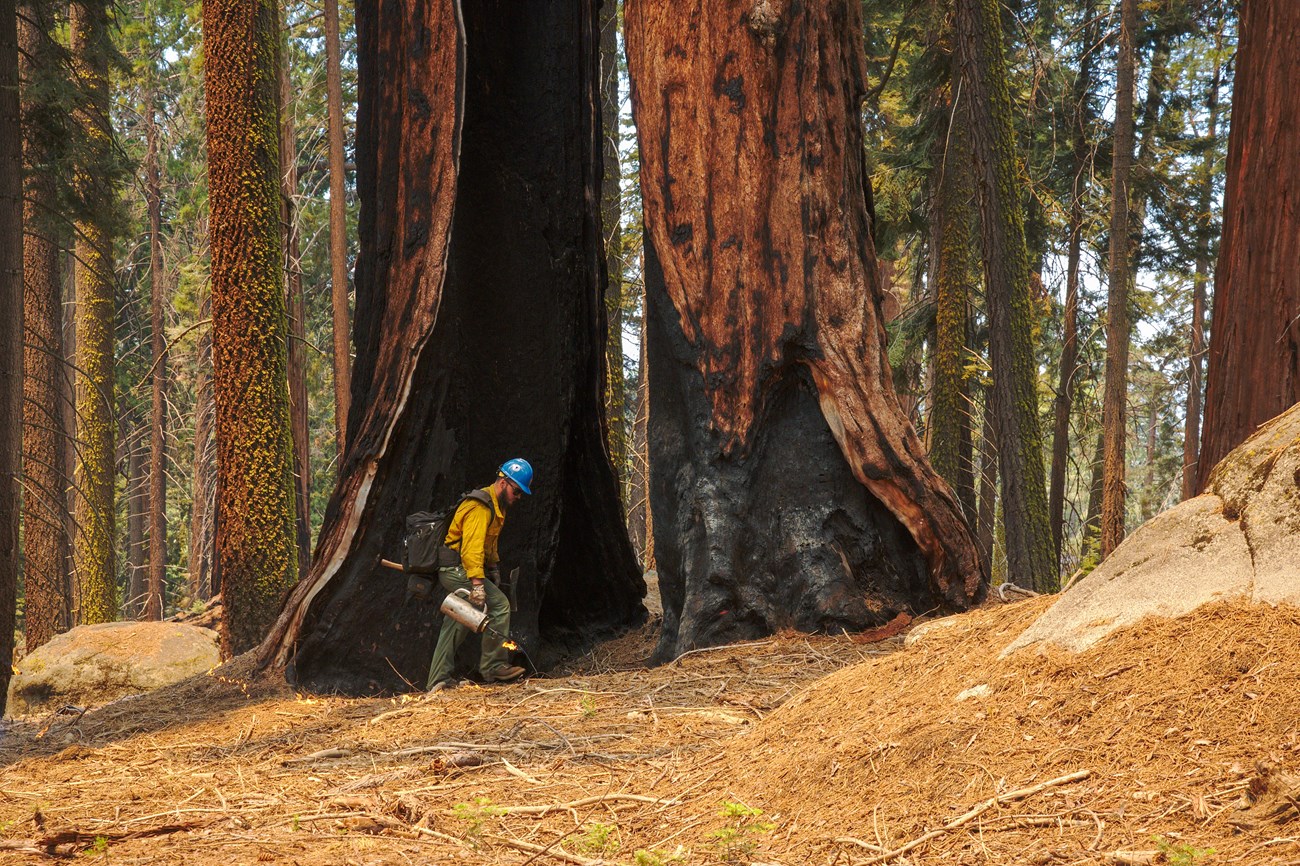
Image credit: NPS / Anthony Caprio
By 1968, the parks, having realized fire’s importance to sequoia groves, began a prescribed burn program. Their first burns in a sequoia grove were in 1969. This program has continued for decades, with second and third burns in some groves, the most recent being the 737-acre Hazelwood-Tharps burn in Giant Forest. Most of the burns haven’t been in backcountry groves, because those are more difficult to access.
An extensive amount of research at the park has focused on improving our understanding of the historical role of fire, the effects of fire frequency and severity, and the effects of subsequent fires. From this, park scientists and fire managers know that burn treatments within 10 to 15 years of a fire will moderate the adverse effects of wildfires. They observed this in the 1987 Pierce, 1988 Buckeye, 2015 Rough, and 2021 KNP Complex wildfires.
Scientists estimated that between 2020 and 2021, three wildfires killed 14–19 percent of all large sequoias on Earth.
The restoration of fire in sequoia groves isn’t a fast process. One century of missed reproduction is not enough to threaten the future of these long-lived trees. But for them to survive long term, there must be enough fire to aid seed germination and seedling survival, create forest openings, and reduce fuels. Young trees must have fire to become giant sequoias and are essential for the survival of this species. Wisely managed prescribed fire will help these groves endure the impacts of a warming climate and more intense wildfires.
But even as fire gives birth to the next generation of sequoias, it can also kill the big trees. In an internal report, scientists estimated that between 2020 and 2021, three wildfires killed 14–19 percent of all large sequoias on Earth, which is clearly unprecedented and unsustainable. Those fires also severely harmed six groves in Sequoia and Kings Canyon National Parks, as well as other groves outside the parks). The parks have proposed replanting sequoias in portions of those groves.
In order to prevent further, unacceptable, losses of thousand-year-old trees, the parks are supplementing their prescribed fire program and enhancing grove resilience to extreme wildfires. They are doing this through hand-thinning treatments, using chain saws to remove encroaching brush, fuels, and small-diameter, non-sequoia species. The focus of these projects are the sequoia groves and the wildland-urban interface, where the forest meets developed land, because protecting life and property are National Park Service priorities. The parks have recently expanded these treatments into more remote grove locations.
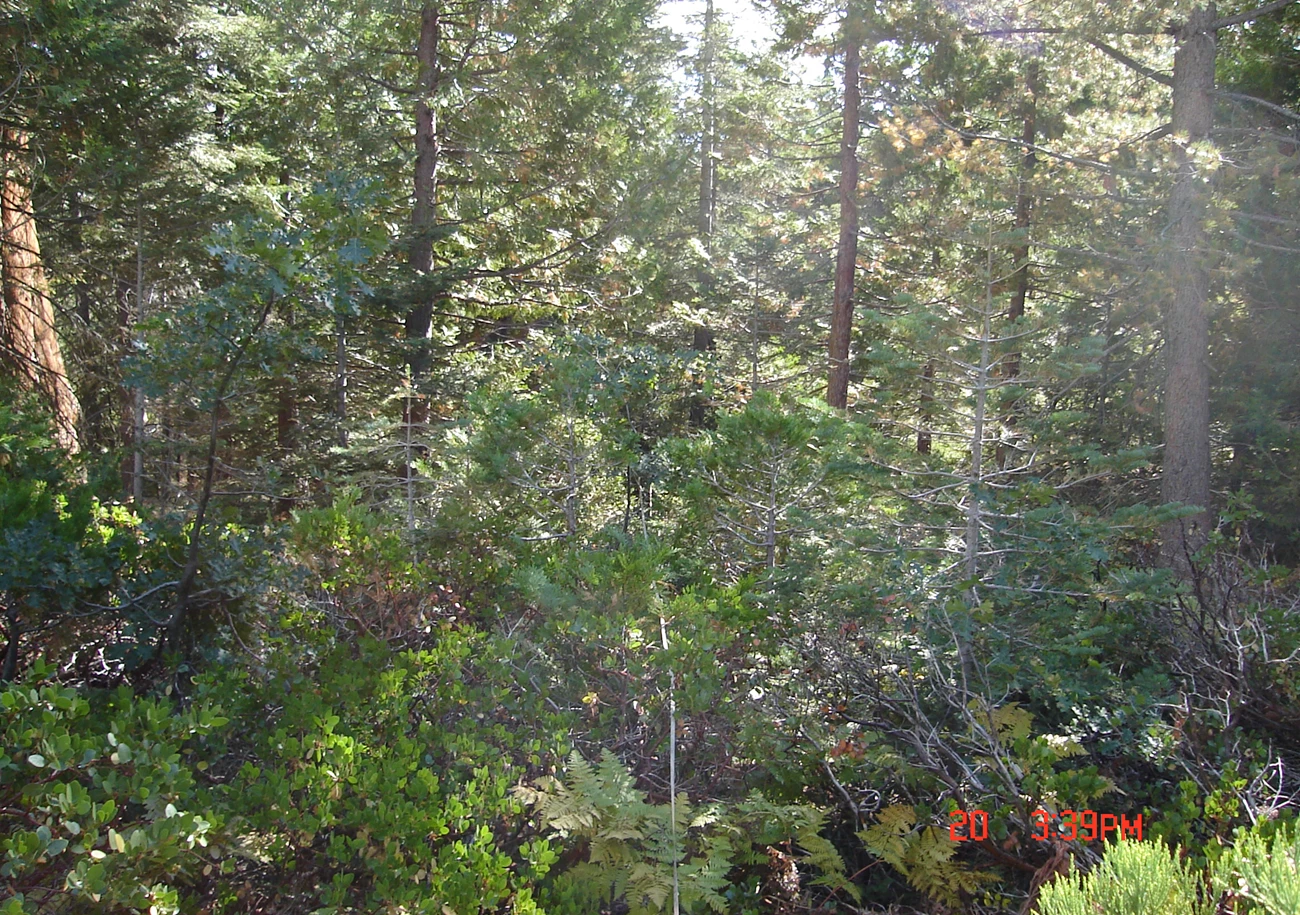
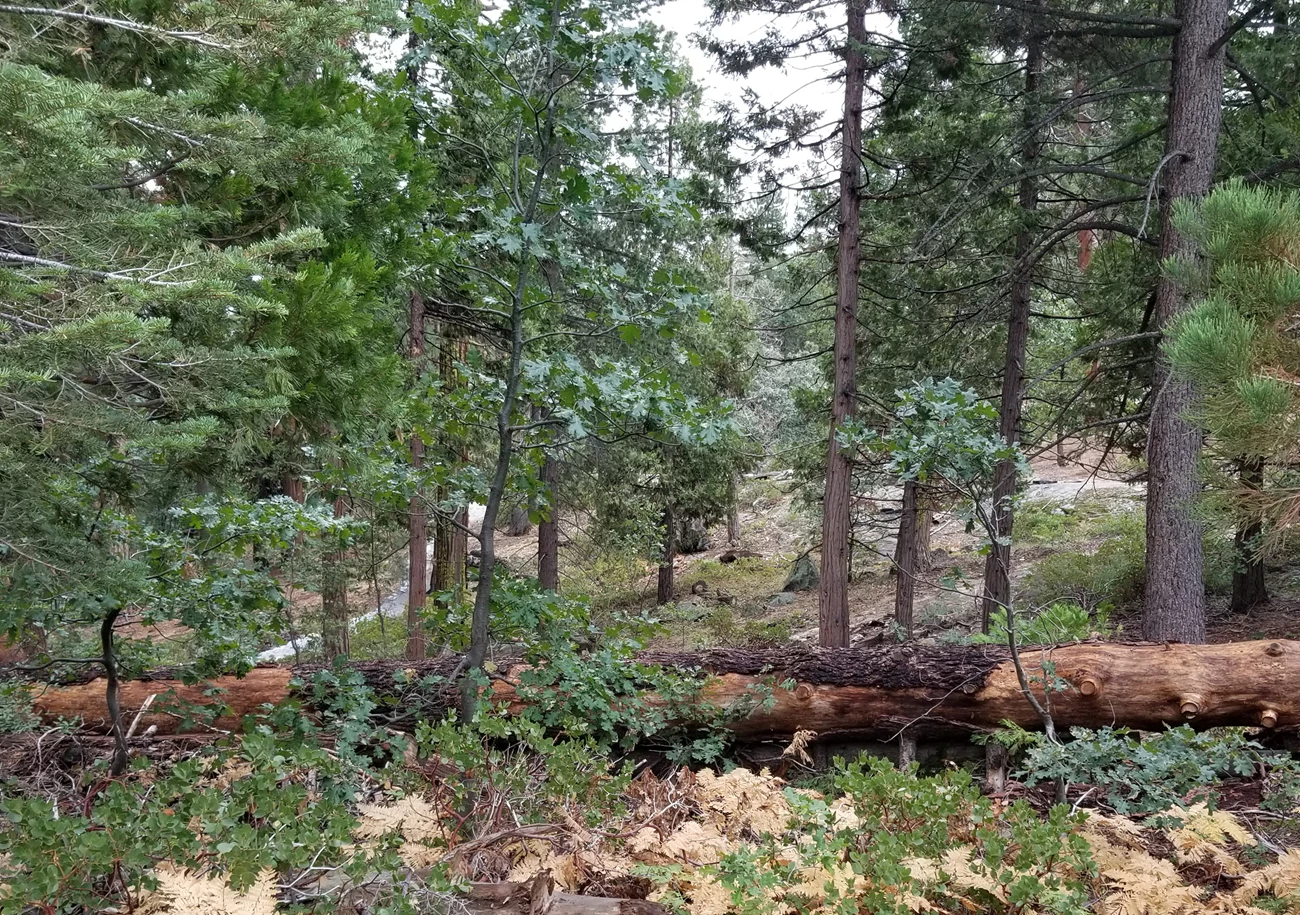
Left image
Monitoring plot #1 in Big Stump Grove in 2005, prior to hand thinning. This grove was logged in the 1890s.
Credit: Image credit: NPS / Anthony Caprio
Right image
The same monitoring plot in 2022, after hand thinning. Drag the slider to the right or left to see the difference.
Credit: Image credit: NPS / Anthony Caprio
KNP Complex and Castle: Lessons Learned from Some Large Sequoia Fires
In 2020 and 2021, the large, at times explosively hot KNP Complex and Castle wildfires burned across more than 106,000 acres in Sequoia and Kings Canyon National Parks. They damaged giant sequoia groves, killing overstory trees. The greatest damage occurred in areas where no prescribed burning or thinning had occurred within the previous 20 to 25 years. This showed us that treating the groves made a difference.
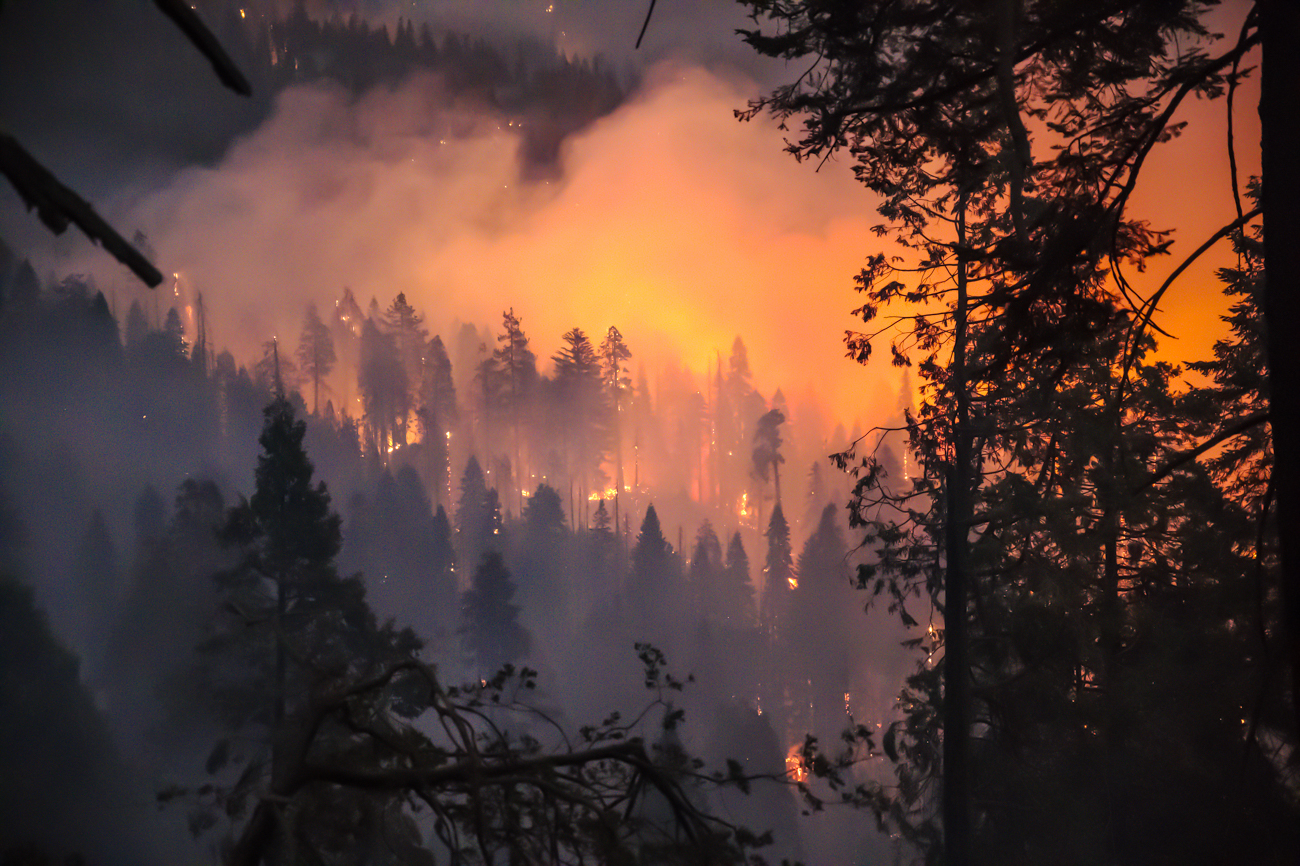
Image credit: NPS / Anthony Caprio
On September 17, 2021, the KNP Complex Fire made a six-mile run upslope from the Marble Fork of the Kaweah River toward park infrastructure at Red Fir and the Wuksachi Lodge. The park has hand-thinned the forest around these developments beginning in 2003, with follow-up prescribed burns in some locations. During the KNP fire, this infrastructure wasn’t damaged, although the fire burned fiercely below and to the west.
“We came back to find everything still there,” said Andrew Cremers, division supervisor for that sector of the fire, as he described what they discovered when they returned the following day. “Same with Red Fir maintenance,” he added. “The structure group had a safe area to come in and re-engage in the morning and had much less prep work to ready the area for the fire impact. This was most apparent around the fire station and ranger cabins that had the most recent thinning and burning done in 2018.”
Fire-effect study plots show that thinning treatments changed forest structure significantly. But thinning alone primarily affected above-ground ladder fuels by removing small-diameter trees, shrubs, and tree branches. It didn’t remove much of the smaller and finer fuels on the soil surface, like leaf litter, fallen needles, twigs, and decaying vegetation, which would typically be removed by prescribed fire. Buildup of these finer surface fuels can result in adverse impacts on overstory trees and soils in extreme wildfire events.
The continued presence of surface fuels highlights the need to treat the forest with prescribed fire after thinning. As a result of lessons learned from the recent large fires, the parks expanded treatments in the groves and across the larger landscape. Manual thinning projects, using chainsaws and removing cut material by hand, are focused on about 500 acres in six giant sequoia groves. Follow-up prescribed burning will include the groves and their surrounding landscapes.
Lassen Acts Pre-emptively to Restore a Healthy Fire Cycle
In 2014, Lassen Volcanic National Park began the Northwest Gateway Project, an ambitious effort to restore a mixed conifer forest using a combination of mechanical treatment and prescribed fire. The 540-acre project is near Manzanita Lake in the northwest portion of the park, adjacent to one of the two primary park entrances. The area receives many visitors annually, has several significant historical structures, and supports park infrastructure, including a campground, camper store, and amphitheater.
Studies of the surrounding forest show that historically, fires burned, on average, every 32 years until 1918, when they effectively ended. In the absence of frequent fires, increasing surface fuel and stand densities favored small, shade-tolerant white firs. Tree deaths from insects and diseases became increasingly common. Colorful aspen trees, which were abundant in these historically open stands, became a rarity.
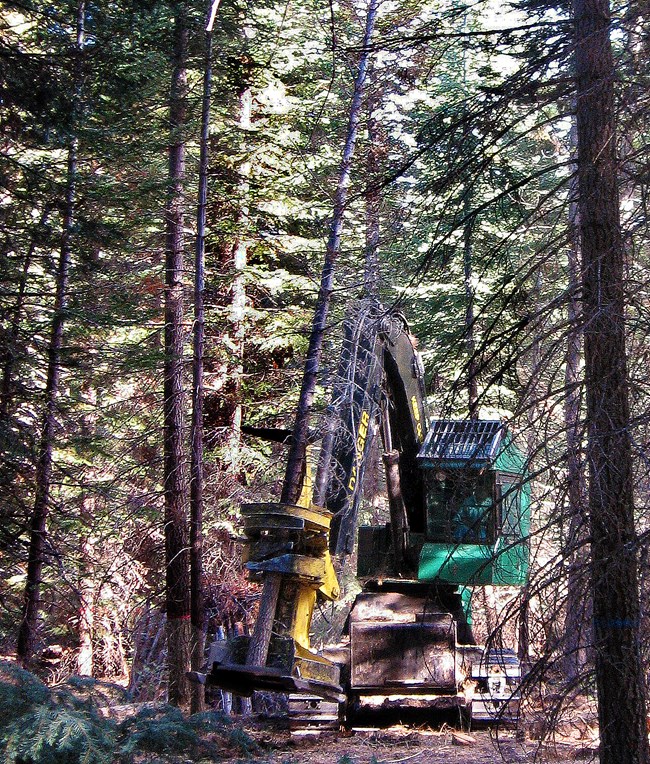
Image credit: NPS
To restore and maintain this mixed conifer forest, park staff first looked at fire history and fire ecology studies to determine the goals of the project. They settled on reducing surface and canopy fuels, restoring aspen populations, and maintaining desirable fire regimes. Another primary objective of these treatments was to create forest conditions that, after one initial treatment, would allow park staff to maintain these stands by using frequent prescribed fire.
Actual wildfire outcomes will depend on things like weather, suppression tactics, and how soon the wildfire occurs after pre-emptive treatments.
In 2014, staff applied site-specific mechanical thinning prescriptions with forestry equipment throughout the project area. They piled and burned leftover small-diameter fuels over the next two winters. The project aimed to reintroduce prescribed fire to the landscape three to five years after mechanical fuel-reduction treatments. The park completed prescribed burns in 2018, 2019, and 2022 and plans to continue a prescribed burning regime for the foreseeable future.
Park scientists and managers evaluated study results through a network of long-term monitoring plots analyzed before and after treatments. The results indicated that the restoration treatments successfully reduced fire hazards and helped residual trees gain greater resistance to wildfire and drought. Actual wildfire outcomes will depend on things like weather, suppression tactics, and how soon the wildfire occurs after pre-emptive treatments.
In 2022, Lassen initiated a similar series of vegetation treatments (mechanical thinning in preparation for prescribed fire) for phase two of the project. This phase addresses unhealthy forest conditions on 476 acres in the wildland urban interface adjacent to the Lassen Park Highway, Lost Creek Campground, and Volcano Adventure Camp, in the northwest portion of the park.
Drought Dries Up Yosemite’s Fire Management Resources
As early as 1970, Yosemite National Park began using broadcast burning, a form of prescribed burning. This is where fire is applied to most or all of an area within well-defined boundaries for reducing fuels, as a resource management treatment, or both. Two years later, the park started allowing lightning-caused backcountry wildfires to burn to help restore natural processes. But the annual acreage of managed fire is not enough to reverse the impacts of over 100 years of fire suppression. Neither can it maintain the fire frequency needed to support a natural fire cycle.
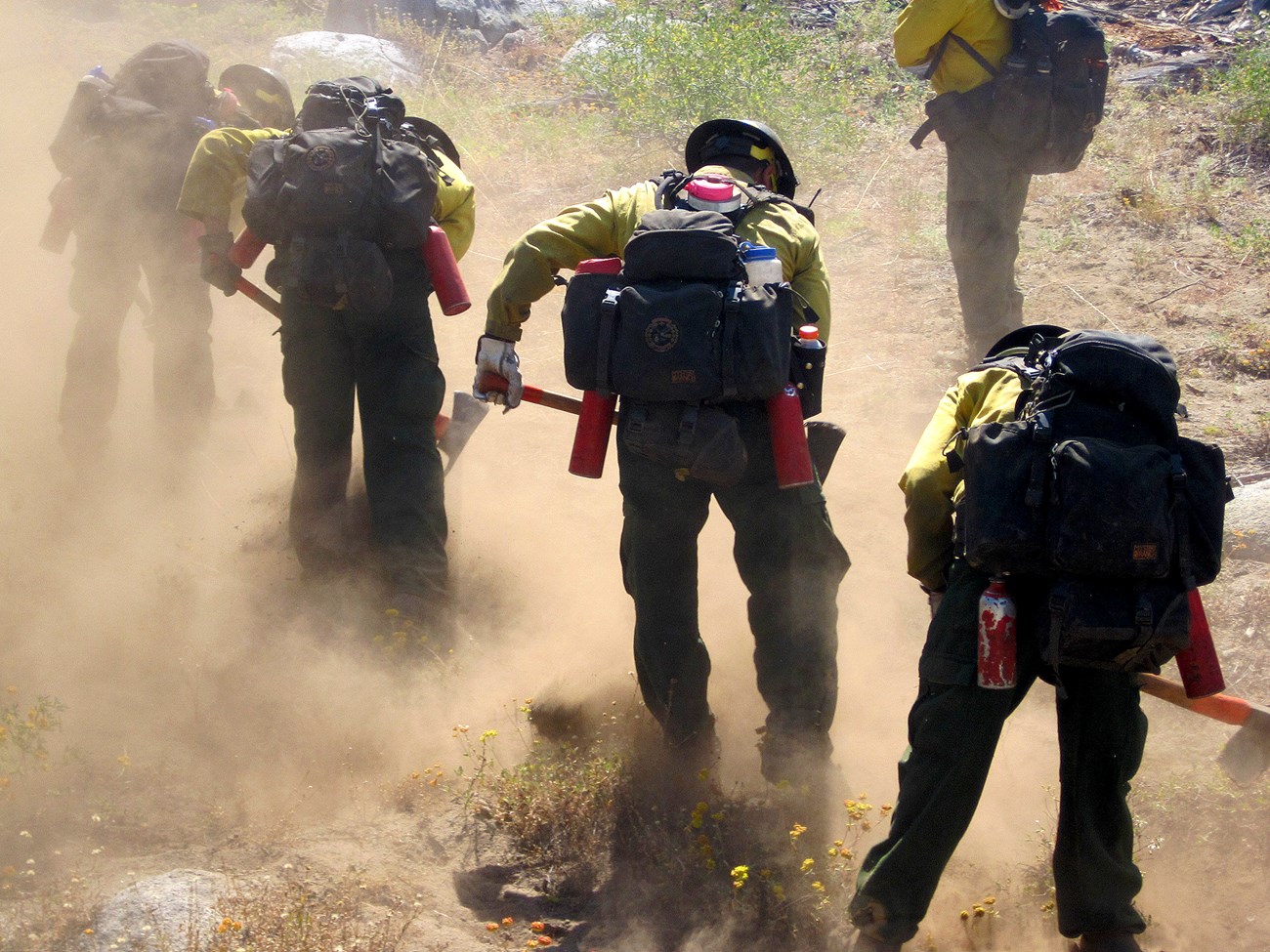
Image credit: NPS / G. Dickman
A century of fire suppression, a record drought in 2012–2016, and climate change have combined to cause a marked increase in catastrophic fires in Yosemite and the Sierra Nevada. These fires adversely affect people’s lives, livelihoods, and health, as well as infrastructure and natural and cultural assets. Public safety, including firefighter safety, is the highest priority for the National Park Service but is increasingly at risk from untreated forests around communities and roads.
The 2012–2016 drought, the hottest and driest period recorded in the park in 1,200 years, killed millions of trees in the Sierra Nevada.
Carrying out the park’s fire management plan has slowed in the last decade. This is because the 2012–2016 drought, the hottest and driest period recorded in the park in 1,200 years, killed millions of trees in the Sierra Nevada. It resulted in the death of an estimated 2.4 million trees in fire management areas and 10 million in nearby Mariposa County alone. In some places, mortality rates were close to 50 percent for all tree species, and 89 percent for large-diameter ponderosa pine trees. Increased temperatures, drought, and beetle kill in the Sierra Nevada changed the amount of canopy and surface fuels. They greatly increased the potential for catastrophic wildfire and made it harder to safely conduct prescribed burns.
Agency and park policy calls for mitigating high hazard tree risk in areas where people expect to be safe, such as campgrounds, buildings, parking lots, and along major roads. Since 2016, the park has felled an average of 5,000 hazard trees annually. During prescribed or wildland fires, trees that pose a threat to firefighters or fire containment are also felled. Policy also dictates that felled trees be removed to reduce fuel loads around communities and roads.
But Yosemite has few personnel to fell and remove hazard trees, including the tree removal necessary for safe prescribed fire. This is one reason why the park burned, on average, only 98 acres by prescription annually over the last decade. By contrast, wildfire burned almost 15,000 park acres per year over the same period. Because of the exponential increase in hazard trees following the 2012–2016 drought, the park prioritized felling trees, but it left most felled hazard trees in place for lack of resources to remove them. Now the park is removing those trees from around campgrounds, communities, sequoia groves, and roads outside of designated wilderness. The felling and removal of hazard trees is a recurring need, one that is accelerating due to continued drought.
The large number of live trees per acre and amount of dead and downed trees make it extraordinarily difficult for firefighters to enter an area to fight a fire. The heavy fuels also contribute to catastrophic wildfires like the 2020 Creek Fire, which nearly entered Yosemite from the neighboring Sierra National Forest. Almost half of the 379,895-acre fire burned in the first four days, and 214 people trapped by the fire had to be rescued by helicopter.
For firefighter and public safety, Yosemite is focusing on removing fuels and mechanically thinning stands of small-diameter trees. This is the key to safely completing prescribed burns and effectively managing wildfires. Mechanical removal of the encroaching younger conifer species along prescribed burn unit boundaries, and around park infrastructure to create defensible space, is the first step to fully carrying out the park’s much-needed prescribed fire management plan.
Washburn: A Pre-treated Forest Thwarts an Aggressive Wildfire
The Washburn Fire started on a hot afternoon in Yosemite National Park in July 2022, within a quarter mile of the entrance to the Mariposa Grove, a famous stand of giant sequoia trees. Bus drivers worked nonstop to shuttle 500 visitors from the grove and through the smoke and flames back to their cars. Firefighters worked through the night to contain the fire, but were unsuccessful in the dry, heavy, dead, and downed fuels that had not seen fire in over a hundred years.
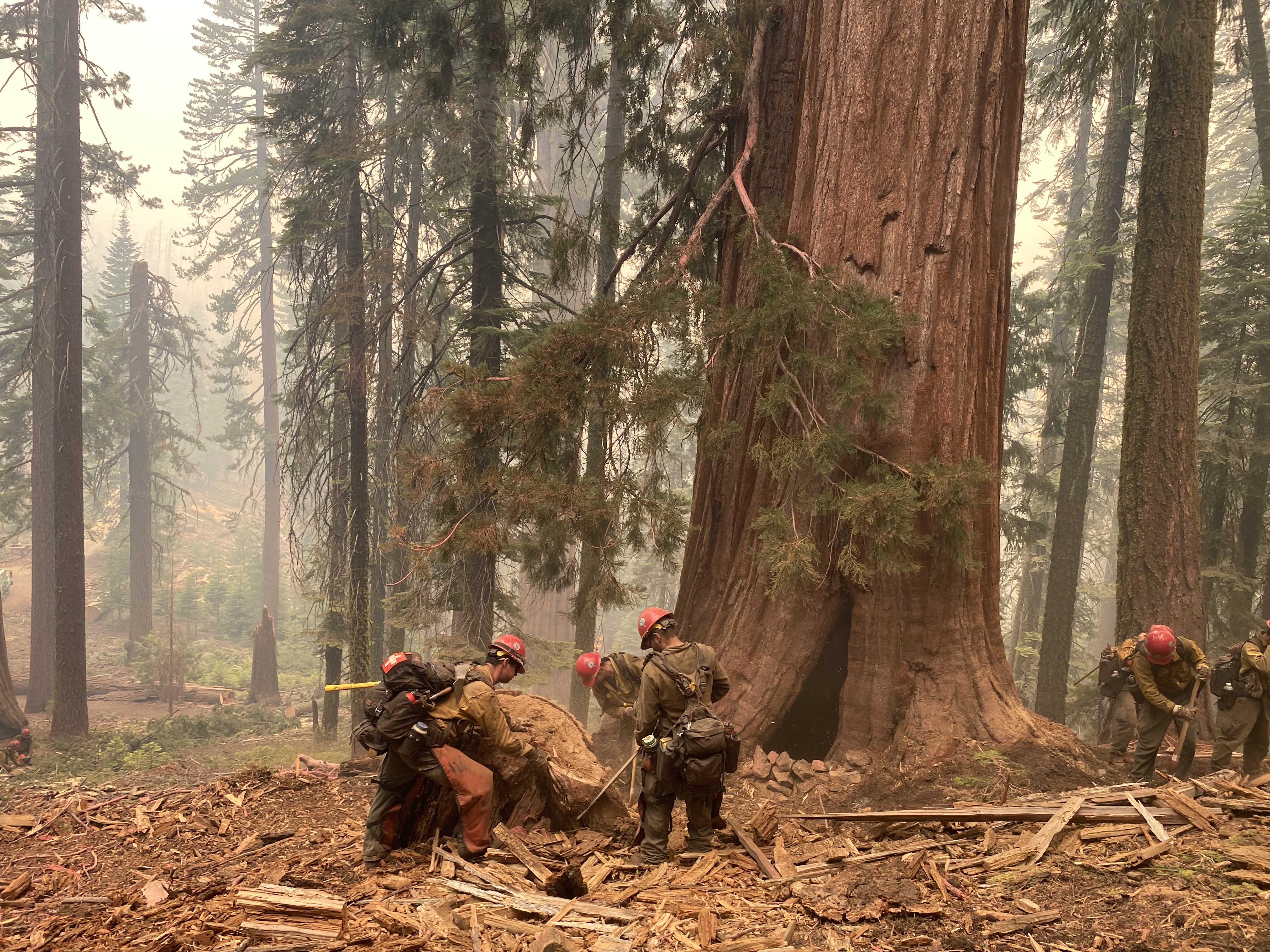
Image credit: NPS / G. Dickman
The fire rapidly reached the grove, including areas the park had most recently treated with prescribed fire. The sudden lack of fuels available to feed the flames slowed the fire enough for firefighters to steer it around the grove and away from most of the sequoias. A half-century of intentional burning had dramatically reduced forest fuel, allowing the blaze to pass through the grove with the trees unscathed. Coauthor Garrett Dickman, a forest ecologist at Yosemite, said, "Luckily, we had 50 years of prescribed fire history. It could have been a very different outcome if we hadn't been preparing for this fire for decades."
On the other flank of the fire, firefighters tried unsuccessfully to work through a fire-suppressed and fuel-laden forest and eventually fell back to Wawona Road. In 2020, a fuel reduction project along the road had removed 60–500 tons of dead and downed logs and trees from 302 acres. That’s an average of about 125 tons per acre. It’s safe to assume that other, untreated areas of the park have similar amounts of unburned fuel. No amount of personal protective equipment could allow firefighters to safely approach an area with 125 tons per acre of burning wood.
Outside of treated areas, the height of the flames, stoked by huge amounts of fuel, dwarfed the tops of 150-foot-tall trees. An aircraft working overhead was hit by a branch propelled skyward by the explosive heat. Fortunately, the pilot suffered no serious injury, and the aircraft was not seriously damaged. The fire eventually reached the treated area along Wawona Road, and flame heights dropped from hundreds of feet to a few feet or inches. Firefighters were then able to safely keep the fire from crossing the road and threatening the small community of Wawona.
Panhandle Proposal at Crater Lake
Crater Lake National Park in Oregon is in the planning stages of a landscape-scale restoration project to save the area of old-growth mixed conifer forests, referred to as the Panhandle, along its southern entrance. This park acquired this area in 1932 because the big trees created a grander, more attractive entrance. But the ecological significance of this forest has increased since its acquisition as old-growth forest throughout the state has declined dramatically.
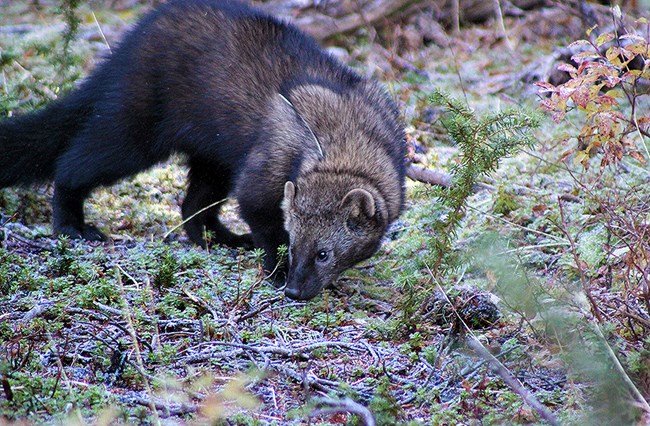
Image credit: NPS / Jess Hoffman
The Panhandle provides critical habitat for old-growth dependent species such as the Northern spotted owl and Pacific fisher.
Years of wildfire suppression throughout Crater Lake significantly increased stand density and fuel loads, shifted tree species from pine to less fire-resistant fir, and reduced understory plant diversity. As a result, the risk of severe wildfire and tree death from disease and insects is greater. Climate change and warming temperatures have exacerbated these conditions through drought stress—and longer fire seasons and insect and pathogen activity periods.
Conditions are now set for a large, severe wildfire. The Panhandle provides critical habitat for old-growth dependent species such as the Northern spotted owl and Pacific fisher. It serves as critical winter habitat for animals like the rare Sierra Nevada red fox and the American black bear. A severe fire would substantially alter the forest’s esthetic and ecological character.
Prescribed fires in the Panhandle from 1976 to 2003 were only marginally successful due to the forest’s condition. Monitoring studies after the fires indicated that tree vigor had declined. Many old-growth trees already stressed from overly dense forest conditions had died, often from bark beetle attacks. Prescribed fire was an added stress that tipped the balance. Now the park proposes to use traditional logging methods to reduce stand density and increase tree vigor. This will allow the park to conduct prescribed burning safely and effectively, without killing the larger trees.
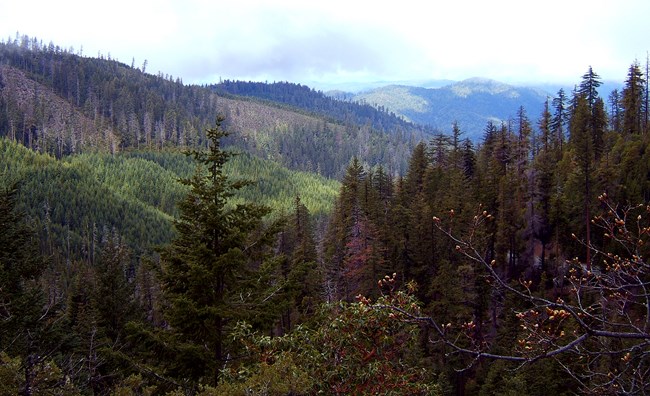
Image credit: NPS
Oregon Caves’ Mountainous Terrain Poses Challenges
Oregon Caves National Monument and Preserve’s 2022 fire management plan advises using mechanical equipment where appropriate. This new plan covers lands transferred to the park in 2014 that have logging plantations full of burnable fuels. As in similar western parks, the conditions in Oregon Caves’ forests are substantially changed from pre-Colonial times due to fire suppression and logging. Given the increase in fire destructiveness and frequency in the region, the park hopes to use mechanical equipment to remove fuels and restore forests.
Because the preserve is steep and mountainous, the park or contractors will do most of the work by hand—not an easy feat! But heavy equipment will be used to create fuel breaks along selected roadsides. The park will avoid steep slopes, loose soils, riparian areas, and other locations unsuitable for this kind of treatment. With a solid set of best management practices in place, Oregon Caves sees using mechanical equipment as a win for protecting the park.
Hope for Reversing a Destructive Trend
It feels as if we are outmatched. The climate and environment around us are changing so fast it’s hard to keep up. And the passive approach to forest management, holding forests in a static state like rare jewels in a glass case, hasn’t kept them safe. Within the past five years, wildfire impacts on communities and public landscapes have been significant.
In 2018, the Carr Fire burned 97 percent of Whiskeytown National Recreation Area and resulted in the deaths of eight people and the destruction of 1,600 homes. Infrastructure, offices, and park seasonal housing went up in flames, and one third of park staff, including Gibson, lost their homes. The nearby Camp Fire soon followed, killing 85 people, and destroying 11,000 homes. In the same month, the Woolsey Fire at Santa Monica Mountains National Recreation Area burned 88 percent of the park, damaging its infrastructure.
In Fall 2020, Colorado had the two largest wildfires in the state’s history, the Cameron Peak and East Troublesome fires, back-to-back events that burned 30,000 acres of Rocky Mountain National Park. Seventy percent of Lava Beds National Monument burned in the wind-driven Caldwell Fire in 2020, and the remaining 30 percent burned in 2021 in the Antelope Fire. In 2021, the Dixie Fire burned 963,000 acres, including about 70 percent of Lassen Volcanic National Park. Three people died in the fire, and 1,330 homes were destroyed.
Active management—mechanical treatments and prescribed fire—may offer the only hope for restoring old-growth forests and making them more resilient to wildfires. And unless these forests are restored to their historic range of variability, many scientists believe they will be permanently altered or lost.
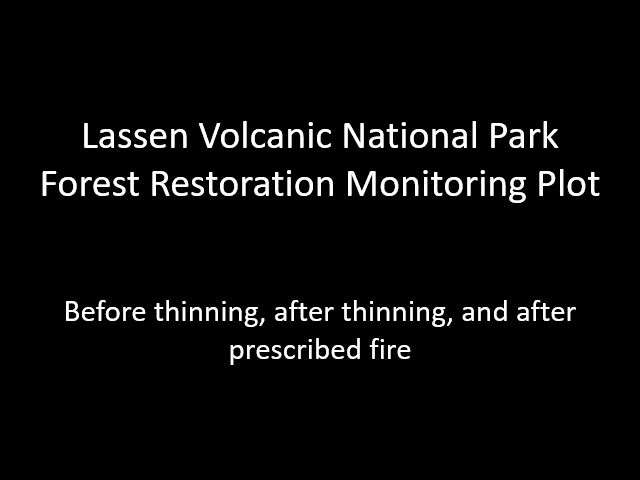
Image credit: NPS
“Managing wildfires requires innovation, creativity, and scientific know-how to solve over a century of suppression-only management.”
National Park Service Deputy Director for Operations Frank Lands formerly oversaw four National Park Service regions—representing more than 60 national park sites—in eight western states. He said, “Managing wildfires requires…innovation, creativity, and scientific know-how…to solve over a century of suppression-only management.” Lands also said we are fortunate that the National Park Service has a “dedicated workforce with the ability to respond to and manage wildfires appropriately” and stressed the importance of the agency’s work with partners, states, and neighboring communities. He added that recently passed legislation—the Inflation Reduction Act and Bipartisan Infrastructure Law—will help “fire managers continue implementing critical strategies” to restore old-growth forests and reduce the incidence of devastating, destructive wildfires.
About the authors
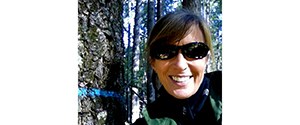
Jennifer Gibson is the post-wildfire program coordinator for the National Park Service. Image courtesy of Jennifer Gibson.
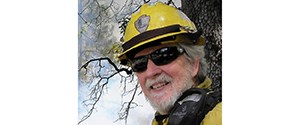
Anthony Caprio is a fire ecologist at Sequoia & Kings Canyon National Parks. Image courtesy of Rene Ardesch.

Garrett Dickman is a forest ecologist at Yosemite National Park. Image courtesy of Garrett Dickman.
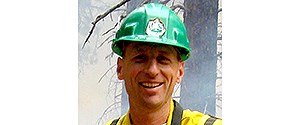
Eric Knapp is a research ecologist with the Pacific Southwest Research Station, USDA Forest Service. Image courtesy of Eric Knapp.
Leonel Arguello is the deputy superintendent for Redwood National and State Parks.
Eamon Engber is a fire planner for the National Park Service’s Pacific West Region.
Jason Teraoka is a forester with Redwood National and State Parks.
Tags
- crater lake national park
- lassen volcanic national park
- oregon caves national monument & preserve
- redwood national and state parks
- sequoia & kings canyon national parks
- whiskeytown national recreation area
- yosemite national park
- park science magazine
- park science journal
- ps v37 n1
- features
- hazards
- management
- fire
- wildfire
- damage
- old growth forest
- forests and woodlands
- habitat
- forestry
- forest thinning
- prescribed burning
- jennifer gibson
- leonel arguello
- anthony caprio
- garrett dickman
- eamon engber
- eric knapp
- jason teraoka
